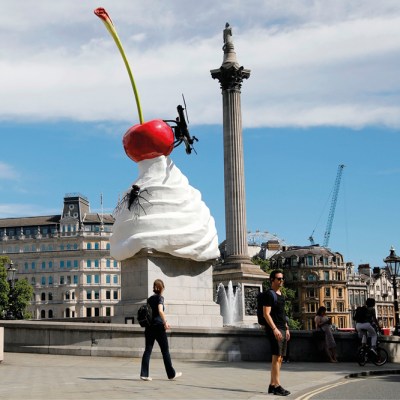From the June 2022 issue of Apollo. Preview and subscribe here.
The first caterers at the National Gallery were volunteers. In the early months of the Second World War, Lady Irene Gater realised, during one of Myra Hess’s morale-boosting lunchtime concerts, that she might not be alone in hankering for sustenance alongside a sonata. By November 1939 a sandwich bar had been installed in the Tuscan Room, staffed by Gater and her ‘amateur nippies’ (as she dubbed her brisk workers). It offered a variety of fillings – honey and raisin, cream cheese and date – as well as ‘station cake’ and coffee.
The pop-up proved so successful that Gater soon launched a second canteen in the basement, serving hot meals to civil servants and members of the armed forces. The provision of food in the gallery had a ‘humanising’ effect, acknowledged its director, Kenneth Clark: it was, he said, ‘One of the chief reasons why the public have come to look on the National Gallery with a more friendly eye.’ There could be no question, after the war, of returning to the ascetic past in which visitors might feast their eyes alone. The National Gallery must have its own restaurant moving forwards.
At first that was confined to a modest room in the basement, although the space soon proved too small. By 1977 the gallery’s annual report would claim that ‘for more than 20 years the Trustees have pressed for a larger restaurant,’ anticipating a refurbishment of the East Wing that would double the capacity of its cafeteria. Then in 1991 came the Sainsbury Wing, with a large, gloomy dining room on its mezzanine level. The gallery’s restaurants had evolved into a business opportunity, geared as much towards revenue as refreshment: in 1990, it appointed a contract caterer, Milburns Restaurants, to manage the dining facilities.
Courtesy Gro Studio, London

The latest partner is Muriel’s Kitchen, a bistro in South Kensington that seems rather friendlier than the multinational ogre (Sodexo) that preceded it. Alongside an espresso bar and a self-service canteen serving homespun sausage rolls and the like, in the space opening on to St Martin’s Lane it has launched Ochre, a restaurant that promises seasonal British produce throughout its ‘contemporary European menu’. Unlike the previous restaurant on this site, which fidgeted at its relationship to the gallery (at one point offering a ‘Gauguin Afternoon Tea’), Ochre makes only sparing reference to the collection upstairs. It takes its name from a pigment, of course, but that’s about it: that the floral fabric worn by front-of-house staff resembles that of Madame Moitessier’s dress as she sat for Ingres is almost certainly wishful thinking.
The space has been opened up to its benefit. Gone are the central partitions that contrived a passage to the gallery from St Martin’s Lane: this is no longer both corridor and restaurant. The aesthetic is a comfortable, contemporary take on mid-century modern: a potted fig tree stands in one corner, naturally, and above one table hangs a chandelier that looks as though it’s made out of shoehorns. The palette, with its notes of olive, raw sienna and, yes, ochre, might be a decorator’s spin on the glaze library of a studio potter. The room feels spacious and intimate at the same time.
The menu is a little harder to navigate. There are ‘Small Plates’ and ‘Plates’, but also ‘Vegetables’ – distinct from ‘Sides’ – listed in between dishes defined by their crockery. Of the smaller options, the English mussels are attractively presented, the half-shells drizzled with cider sauce and attended by small cubes of diced apple (although £9.25 for eight mussels feels a little steep). The mussels are small, sweet and meaty, and the sharp accompaniment of the apple is well judged. Saddleback pork and Westcombe cheddar croquettes (£9) roll around the plate as the waiter sets them down: three runaway deep-fried golf balls. These are as crunchy and cheesy as you’d hope for, if a little light on seasoning.
Perhaps the waiter is puzzled by ‘Vegetables’, too, for instead of tempura cauliflower from that section of the menu, she brings the charred cauliflower (£16) from ‘Plates’. It is a delicious mistake. The big slab of cauliflower is perfectly caramelised, retaining its bite in the centre but sliding into a lovely fudginess at the edges. There is a hint of heat, as well as an intense savouriness from a smooth cauliflower puree, strips of woody chanterelle mushroom and capers done to a satisfying crisp. Grilled prawns (five for £18) cannot compete: the underseasoned prawns are drowned out by an acidic mango dressing on the salad beneath them. A harissa spiced lamb burger (£14) is better, the patty lean but juicy and well complemented by cumin yoghurt, pickled red cabbage and salty, creamy feta: it is one sweet note away from a damn good burger.
The tarte tatin (£7.50) is excellent, all butter, cinnamon and caramel – and insistently, winningly ochre. Station cake and honey sandwiches may be long gone from the National Gallery. But for the first time in my memory, at least, it has a restaurant to be proud of – with food that sets out gladden the public.
From the June 2022 issue of Apollo. Preview and subscribe here.


